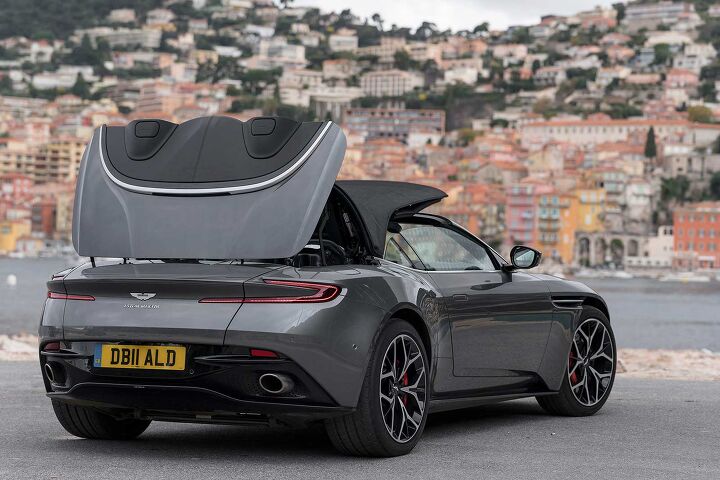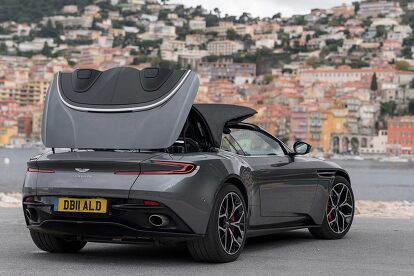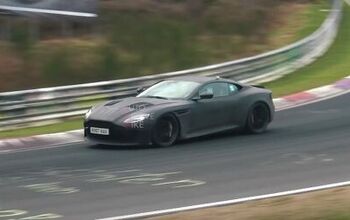There's a Damn-Good Reason Why the Aston Martin DB11 Volante Has a Soft Top

“You look back at them, there aren’t very many elegant shapes. There aren’t very many elegant cars,” said Julian Nunn, lead exterior designer at Aston Martin Lagonda Ltd.
This why the British firm’s DB11 wears a fabric lid rather than one made of a composite material or pressed metal.
Folding hardtops certainly have their advantages, providing additional structural rigidity to a vehicle, doing a better job of keeping the weather out and of course offering greater security than a cloth roof ever could. Unfortunately, these upsides are typically offset by higher cost, greater complexity and weight as well as packaging issues. In fact, the DB11’s rear fenders had to be pumped up 11 millimeters to accommodate a folding roof.
But none of those reasons are why Aston Martin eschewed a hardtop on the Volante, their sultry open-air grand-tourer.
“Every car that we do in design has to be elegant. It’s got to sit alongside all the other classics. It’s got to be part of the family,” explained Nunn. “If it’s not part of the family we’re not doing something right.”
Nunn added that retractable hardtops also have more split lines and uglier mechanisms, things that are simply inappropriate on an Aston Martin. “It doesn’t give you the beauty that you need for these cars.”
SEE ALSO: 2017 Rolls-Royce Dawn Review – VIDEO
Similar motives pushed Rolls-Royce to opt for fabric on the Dawn convertible, noting in their press materials the decision was “for reasons of aesthetics, romance and brand appropriateness.”
In designing the DB11 and its Volante variant, Nunn said the single biggest challenge was keeping that hallmark grace. “It has to look and feel like an Aston Martin even though… we’ve gone away from where we were traditionally in the market,” he said. “There’s a lot of tension in the surfaces, a lot of tension in the lines,” but it hasn’t lost that classic refinement.
And this sort of restraint can be a challenge in the 21st century. According to Nunn, designers are always being pressured to do more, to make cars look different, especially in mass-market segments, something that creates complexity. “There are features, there are things that you don’t need there,” he explained. Superfluous styling add-ons even have a special name. “I call [them] gargoyles,” said Nunn.
SEE ALSO: 10 Differences Between the Aston Martin DB11 V8 and V12
Marek Reichman is Aston Martin’s executive vice president and chief creative officer. Speaking of the boss Nunn noted, “One of his sayings is, ‘If there’s a line on the car that’s not doing something, take it off,’” which goes right back to his comments about elegance, not muddying a design with unnecessary creases or trim.
Perhaps helping deliver a more cohesive look, Nunn said, “Again, Aston Martin does something unique where the designer of the exterior will design the headlamps, they’ll design the wheels, they’ll design the rear lamps… It’s not just the exterior form.”
SEE ALSO: 2018 Aston Martin DB11 Volante Review – VIDEO
In creating the DB11 Nunn said they revised the side-view mirrors 24 times before getting them just right. Even something as seemingly simple as the mirrors packed with technology. There’s a camera mounted in each housing, there are hidden-until-lit turn signal element and there are tooling and cost constraints, including getting the viewing angles just right to meet legal requirements.
“I know, it sounds crazy,” Nunn admitted. But car design isn’t easy, especially at a brand like Aston Martin.
Discuss this story on our Luxury-Lifestyle Forum

Born and raised in metro Detroit, Craig was steeped in mechanics from childhood. He feels as much at home with a wrench or welding gun in his hand as he does behind the wheel or in front of a camera. Putting his Bachelor's Degree in Journalism to good use, he's always pumping out videos, reviews, and features for AutoGuide.com. When the workday is over, he can be found out driving his fully restored 1936 Ford V8 sedan. Craig has covered the automotive industry full time for more than 10 years and is a member of the Automotive Press Association (APA) and Midwest Automotive Media Association (MAMA).
More by Craig Cole






































































Comments
Join the conversation